How to Compute Whether Biomass Fuels Are Carbon Neutral
Abstract
1. Introduction
1.1. Motivation
1.2. Relevance
1.3. Context
2. Materials and Methods
2.1. Representation of the Model Parameters
2.1.1. Basic Climatic Data
2.1.2. Basic Biological Data, Net Primary Productivity (NPP) and Phytomass (P)
2.1.3. Decomposition of Plant Matter (Litter Depletion LD and Soil Organic Carbon Depletion SOCD)
2.1.4. Political and Economic Input Data
2.1.5. Historic CO2 Emission Data
2.1.6. Input Data for the Energy Strategy Module: Population and Economic Growth
2.2. Checking Accuracy and Sensitivities of Various CEBM Program Parts
2.2.1. Sensitivity Studies through Preparatory “Zero Runs”
2.2.2. Sensitivity Studies as a Result of Different Deforestation Scenarios
2.2.3. Assumption of a Uniform Atmosphere
2.2.4. The Biospheric Carbon Fluxes
2.2.5. The Ocean Model
- The model used in the CEBM is a one-dimensional “box-diffusion model” with spatial resolution only in the vertical axis, but not along the earth’s surface (see Figure 14 at left and second left).
- A first improvement would be the differentiation into different latitudes (two-dimensional models). Here the global ocean is divided into ring-shaped zones surrounding the globe. CO2 diffusion also occurs between the various ocean rings. Each of these sub-oceans is assigned the corresponding geographical extent, which comes from the distribution of the continents on the globe.
- Two-dimensional “upwelling” models: In addition to diffusion, vertical mechanical mixing of the ocean’s water masses is assumed. This also means that carbon is transported in the form of CO2. An example of this is the model designed [103] at IIASA. This also has a “wind-driven” component, which models the movement of oceanic water masses due to wind activity. The flow conditions are shown in Figure 14 at third left, where only the northern hemisphere is taken into account.
- Three-dimensional ocean models with spatial resolution in all three coordinate directions are being developed, for example, at the Max Planck Institute in Hamburg (MPI) for Meteorology. Horizontal flows circulating around the globe can also be depicted (see Figure 14 at fourth left). Such models are connected to the “High Resolution Biosphere Model” (HRBM) by [104] as part of the European carbon cycle modelling program ESCOBA [103,105,106,107]. The reference value of 1.8 Gt C can serve as a guideline for the absorption capacity of the model ocean of the Max Planck Institute (MPI) Hamburg according to an oral communication by authors Heimann and Meier-Reimer at MPI. This value is slightly lower than the value of the model ocean used in the CEBM, and thus seems consistent.
3. Generating Results
3.1. Modeling Biomass Fuels
3.2. Modeling the Processes Associated with Deforestation
3.3. Where Does Emitted CO2 Ultimately Go?
3.4. Results Regarding Carbon Neutrality of Biomass Fuels
- (a)
- The business-as-usual scenario represents to point of start for all scenario thinking (i.e., what-if logic) and means the threatening but likely future status which should not at all take place because of its clearly climate-threatening effects.
- (b)
- The base-case scenario means an already (over-)optimistic future for which enormous reductions in energy demand growth must be achieved, namely lowering the annual growth rate from +3% to +1%.
- (c)
- The biomass scenario means to start out from the energy demand defined by the (optimistic) base-case scenario and to cover it by biomass fuels to the extent which was computed by the CEBM as the planetary maximum.
- (d)
- The low-emission scenario means the same as above only that all biomass in (c) is replaced by non-carbon energy in (d). Consequently, any difference between the (c) and (d) scenarios equals the amount to which biomass fuels are not truly carbon neutral.
- (e)
- As an orientation, this scenario means a current reduction target. It is this emission path that actually should be reached for a sustainable and climate-compatible future.
3.5. On the Degree of C-Neutrality of Biomass
3.6. Comparison of the Mitigation Potential of the Different Scenarios
4. Conclusions
Funding
Data Availability Statement
Acknowledgments
Conflicts of Interest
References
- European Commission. The European Green Deal—Striving to Be the First Climate-Neutral Continent. 2024. Available online: https://commission.europa.eu/strategy-and-policy/priorities-2019-2024/european-green-deal_en (accessed on 1 May 2024).
- BMK. Europäischer Green Deal. Bundesministerium für Klimaschutz, Umwelt, Energie, Mobilität, Innovation und Technologie. 2024. Available online: https://www.bmk.gv.at/themen/klima_umwelt/eu_international/euop_greendeal.html (accessed on 1 May 2024).
- European Commission. Climate Action and the Green Deal. 2024. Available online: https://commission.europa.eu/strategy-and-policy/priorities-2019-2024/european-green-deal/climate-action-and-green-deal_en (accessed on 1 May 2024).
- Wang, B.; Hu, J.; Chen, W.; Chang, C.; Pang, S.; Li, P. Characteristic analysis and kinetics description for biochar-based catalysts coking during the biomass catalytic pyrolysis. Fuel 2024, 362, 130769. [Google Scholar] [CrossRef]
- Yang, Y.; Østergaard, P.A.; Wen, W.; Zhou, P. Heating transition in the hot summer and cold winter zone of China: District heating or individual heating? Energy 2024, 290, 130283. [Google Scholar] [CrossRef]
- Safder, U.; Loy-Benitez, J.; Yoo, C. Techno-economic assessment of a novel integrated multigeneration system to synthesize e-methanol and green hydrogen in a carbon-neutral context. Energy 2024, 290, 130104. [Google Scholar] [CrossRef]
- Yang, D.; Li, S.; He, S. Zero/negative carbon emission coal and biomass staged co-gasification power generation system via biomass heating. Appl. Energy 2024, 357, 122469. [Google Scholar] [CrossRef]
- Sharafilaleh, S.; Fatemi Alavi, S.H.; Soltani, S.; Mahmoudi, S.M.S.; Rosen, M.A. A novel supercritical carbon dioxide combined cycle fueled by biomass: Thermodynamic assessment. Renew. Energy 2024, 222, 119874. [Google Scholar] [CrossRef]
- Li, Y.; Wang, Y.; Zhou, R.; Qian, H.; Gao, W.; Zhou, W. Energy transition roadmap towards net-zero communities: A case study in Japan. Sustain. Cities Soc. 2024, 100, 105045. [Google Scholar] [CrossRef]
- Cheng, F.; Luo, H.; Jenkins, J.D.; Larson, E.D. Impacts of the Inflation Reduction Act on the Economics of Clean Hydrogen and Synthetic Liquid Fuels. Environ. Sci. Technol. 2023, 57, 15336–15347. [Google Scholar] [CrossRef] [PubMed]
- Zhu, S.; Preuss, N.; You, F. Advancing sustainable development goals with machine learning and optimization for wet waste biomass to renewable energy conversion. J. Clean. Prod. 2023, 422, 138606. [Google Scholar] [CrossRef]
- Li, L.; Li, J.; Peng, L.; Wang, X.; Sun, S. Optimal pathway to urban carbon neutrality based on scenario simulation: A case study of Shanghai, China. J. Clean. Prod. 2023, 416, 137901. [Google Scholar] [CrossRef]
- Ono, R.; Fukuda, Y.; Fujii, M.; Yamagata, Y. Assessment of unutilized woody biomass energy and the cost and greenhouse gas emissions of woody biomass power plants in Hokkaido, Japan. Clean. Energy Syst. 2023, 6, 100084. [Google Scholar] [CrossRef]
- Liu, T.; Yabu, H. Biomass-Derived Electrocatalysts: Low-Cost, Robust Materials for Sustainable Electrochemical Energy Conversion. Adv. Energy Sustain. Res. 2024, 5, 2300168. [Google Scholar] [CrossRef]
- Velvizhi, G.; Jacqueline, P.J.; Shetti, N.P.; Latha, K.; Mohanakrishna, G.; Aminabhavi, T.M. Emerging trends and advances in valorization of lignocellulosic biomass to biofuels. J. Environ. Manag. 2023, 345, 118527. [Google Scholar] [CrossRef] [PubMed]
- Negi, H.; Suyal, D.C.; Soni, R.; Giri, K.; Goel, R. Indian Scenario of Biomass Availability and Its Bioenergy-Conversion Potential. Energies 2023, 16, 5805. [Google Scholar] [CrossRef]
- Yang, H.; Ciais, P.; Frappart, F.; Li, X.; Brandt, M.; Fensholt, R.; Fan, L.; Saatchi, S.; Besnard, S.; Deng, Z.; et al. Global increase in biomass carbon stock dominated by growth of northern young forests over past decade. Nat. Geosci. 2023, 16, 886–892. [Google Scholar] [CrossRef]
- Tan, Z.; Zeng, X.; Lin, B. How do multiple policy incentives influence investors’ decisions on biomass co-firing combined with carbon capture and storage retrofit projects for coal-fired power plants? Energy 2023, 278, 127822. [Google Scholar] [CrossRef]
- Agrawal, D.; Awani, K.; Nabavi, S.A.; Balan, V.; Jin, M.; Aminabhavi, T.M.; Dubey, K.K.; Kumar, V. Carbon emissions and decarbonisation: The role and relevance of fermentation industry in chemical sector. Chem. Eng. J. 2023, 475, 146308. [Google Scholar] [CrossRef]
- Cowan, A.E.; Klass, S.H.; Winegar, P.H.; Keasling, J.D. Microbial production of fuels, commodity chemicals, and materials from sustainable sources of carbon and energy. Curr. Opin. Syst. Biol. 2023, 36, 100482. [Google Scholar] [CrossRef]
- Abbasi, T.; Abbasi, S.A. Biomass energy and the environmental impacts associated with its production and utilization. Renew. Sustain. Energy Rev. 2010, 14, 919–937. [Google Scholar] [CrossRef]
- Azar, C.; Lindgren, K.; Larson, E.; Möllersten, K. Carbon capture and storage from fossil fuels and biomass—Costs and potential role in stabilizing the atmosphere. Clim. Change 2006, 74, 47–79. [Google Scholar] [CrossRef]
- Wang, C.; Raza, S.A.; Adebayo, T.S.; Yi, S.; Shah, M.I. The roles of hydro, nuclear and biomass energy towards carbon neutrality target in China: A policy-based analysis. Energy 2023, 262, 125303. [Google Scholar] [CrossRef]
- Demirbas, A. Combustion characteristics of different biomass fuels. Prog. Energy Combust. Sci. 2004, 30, 219–230. [Google Scholar] [CrossRef]
- Kraxner, F.; Nilsson, S.; Obersteiner, M. Negative emissions from BioEnergy use, carbon capture and sequestration (BECS)—The case of biomass production by sustainable forest management from semi-natural temperate forests. Biomass Bioenergy 2003, 24, 285–296. [Google Scholar] [CrossRef]
- Ozolin, S.A.; Pakere, I.; Jaunzems, D.; Blumberga, A.; Gravelsin, A.; Dubrovskis, D.; Dagís, S. Can energy sector reach carbon neutrality with biomass limitations? Energy 2022, 249, 123797. [Google Scholar] [CrossRef]
- Muench, S.; Guenther, E. A systematic review of bioenergy life cycle assessments. Appl. Energy 2013, 112, 257–273. [Google Scholar] [CrossRef]
- Yang, C.; Kwon, H.; Bang, B.; Jeong, S.; Lee, U. Role of biomass as low-carbon energy source in the era of net zero emissions. Fuel 2022, 328, 125206. [Google Scholar] [CrossRef]
- Liu, T.; Miao, P.; Shi, Y.; Tang KH, D.; Yap, P. Recent advances, current issues and future prospects of bioenergy production: A review. Sci. Total Environ. 2022, 810, 152181. [Google Scholar] [CrossRef] [PubMed]
- Nayak, S.; Goveas, L.C.; Selvaraj, R.; Vinayagam, R.; Manickam, S. Advances in the utilisation of carbon-neutral technologies for a sustainable tomorrow: A critical review and the path forward. Bioresour. Technol. 2022, 364, 128703. [Google Scholar] [CrossRef] [PubMed]
- He, M.; Sun, Y.; Han, B. Green carbon science: Efficient carbon resource processing, utilization, and recycling towards carbon neutrality. Angew. Chem. Int. Ed. 2022, 61, e202112835. [Google Scholar] [CrossRef]
- Rittmann, B.E. Opportunities for renewable bioenergy using microorganisms. Biotechnol. Bioeng. 2008, 100, 203–212. [Google Scholar] [CrossRef]
- Sahin, Y. Environmental impacts of biofuels. Energy Educ. Sci. Technol. Part A Energy Sci. Res. 2011, 26, 129–142. [Google Scholar]
- Kun, Z. The EU renewable energy policy and its impact on forests. In De Gruyter Handbook of Sustainable Development and Finance; Walter de Gruyter: Berlin, Germany, 2022; pp. 219–248. [Google Scholar]
- Otsuki, T.; Komiyama, R.; Fujii, Y.; Nakamura, H. Temporally detailed modeling and analysis of global net zero energy systems focusing on variable renewable energy. Energy Clim. Change 2023, 4, 100108. [Google Scholar] [CrossRef]
- Abouemara, K.; Shahbaz, M.; Mckay, G.; Al-Ansari, T. The review of power generation from integrated biomass gasification and solid oxide fuel cells: Current status and future directions. Fuel 2024, 360, 130511. [Google Scholar] [CrossRef]
- Fatiguso, M.; Valenti, A.R.; Ravelli, S. Comparative energy performance analysis of micro gas turbine and internal combustion engine in a cogeneration plant based on biomass gasification. J. Clean. Prod. 2024, 434, 139782. [Google Scholar] [CrossRef]
- Paraschiv, L.S.; Paraschiv, S. Contribution of renewable energy (hydro, wind, solar and biomass) to decarbonization and transformation of the electricity generation sector for sustainable development. Energy Rep. 2023, 9, 535–544. [Google Scholar] [CrossRef]
- Devi, A.; Bajar, S.; Sihag, P.; Sheikh, Z.U.D.; Singh, A.; Kaur, J.; Bishnoi, N.R.; Pant, D. A panoramic view of technological landscape for bioethanol production from various generations of feedstocks. Bioengineered 2023, 14, 81–112. [Google Scholar] [CrossRef] [PubMed]
- Singh, K.; Meena, R.S.; Kumar, S.; Dhyani, S.; Sheoran, S.; Singh, H.M.; Pathak, V.V.; Khalid, Z.; Singh, A.; Chopra, K.; et al. India’s renewable energy research and policies to phase down coal: Success after Paris agreement and possibilities post-Glasgow Climate Pact. Biomass Bioenergy 2023, 177, 106944. [Google Scholar] [CrossRef]
- Gupta, S.; Kumar, R.; Kumar, A. Green hydrogen in India: Prioritization of its potential and viable renewable source. Int. J. Hydrogen Energy 2024, 50, 226–238. [Google Scholar] [CrossRef]
- Takeishi, K.; Krewinkel, R. Advanced Gas Turbine Cooling for the Carbon-Neutral Era. Int. J. Turbomach. Propuls. Power 2023, 8, 19. [Google Scholar] [CrossRef]
- Koivunen, T.; Khosravi, A.; Syri, S. The role of power-to-hydrogen in carbon neutral energy and industrial systems: Case Finland. Energy 2023, 284, 128624. [Google Scholar] [CrossRef]
- Ahamer, G. Why Biomass Fuels Are Principally Not Carbon Neutral. Energies 2022, 15, 9619. [Google Scholar] [CrossRef]
- Le, T.T.; Sharma, P.; Le, H.C.; Le, H.S.; Osman, S.M.; Truong, T.H.; Le, D.T.N.; Rowinski, L.; Tran, V.D. A glass-box approach for predictive modeling based on experimental data for a waste biomass derived producer gas-powered dual-fuel engine. Int. J. Hydrogen Energy 2024, 58, 1122–1137. [Google Scholar] [CrossRef]
- Ahamer, G. A Structured Basket of Models for Global Change. In Environmental Information Systems in Industry and Public Administration (EnvIS); Rautenstrauch, C., Patig, S., Eds.; Idea Group Publishing: Hershey, PA, USA, 2001; Chapter 6. [Google Scholar] [CrossRef][Green Version]
- Ahamer, G. Influence of an Enhanced Use of Biomass for Energy on the CO2 Concentration in the Atmosphere. Int. J. Glob. Energy Issues 1994, 6, 112–131. [Google Scholar]
- Kukharets, S.; Jasinskas, A.; Golub, G.; Sukmaniuk, O.; Hutsol, T.; Mudryk, K.; Čėsna, J.; Glowacki, S.; Horetska, I. The Experimental Study of the Efficiency of the Gasification Process of the Fast-Growing Willow Biomass in a Downdraft Gasifier. Energies 2023, 16, 578. [Google Scholar] [CrossRef]
- Nastasi, B.; Markovska, N.; Puksec, T.; Duić, N.; Foley, A. Techniques and technologies to board on the feasible renewable and sustainable energy systems. Renew. Sustain. Energy Rev. 2023, 182, 113428. [Google Scholar] [CrossRef]
- Green, J.F.; Reyes, R.S. The history of net zero: Can we move from concepts to practice? Clim. Policy 2023, 23, 901–915. [Google Scholar] [CrossRef]
- Tran, H.; Juno, E.; Arunachalam, S. Emissions of wood pelletization and bioenergy use in the United States. Renew. Energy 2023, 219, 119536. [Google Scholar] [CrossRef]
- Tregub, O.A. Preferential taxation of carbon dioxide emissions from biofuel burning in the context of reassessment of the impact of bioenergy on the climate. Econ. Law 2023, 43–51. [Google Scholar] [CrossRef]
- Podolets, R.; Diachuk, O.; Semeniuk, A.; Serebrennikov, B.; Trypolska, G.; Yuhymets, R.; Yevstihnieieva, O. Rebuilding Ukraine with a Resilient, Carbon-Neutral Energy System; UNECE: Geneva, Switzerland, 2023; Available online: https://unece.org/sustainable-energy/publications/rebuilding-ukraine-resilient-carbon-neutral-energy-system (accessed on 1 May 2024).
- Sahni, T.; Verma, D.; Kumar, S. Biochar: A Pyrolyzed Green Fuel from Paddy Straw. In Paddy Straw Waste for Biorefinery Applications; Srivastava, N., Verma, B., Mishra, P.K., Eds.; Clean Energy Production Technologies; Springer: Singapore, 2024. [Google Scholar] [CrossRef]
- Gürdil, G.A.K.; Demirel, B.; Cevher, E.Y. The conceptualization of agricultural residues: Unlocking potential for sustainability. BIO Web Conf. 2024, 85, 01068. [Google Scholar] [CrossRef]
- Qu, K.; Zhang, Y.; Ma, K. Study on the future development prospects of biomass energy in towns, townships, and subdistricts under multi-scenarios—A case study of Harbin City. J. Clean. Prod. 2024, 448, 141707. [Google Scholar] [CrossRef]
- Schlamadinger, B.; Spitzer, J.; Kohlmaier, G.H.; Lüdeke, M. Carbon balance of bioenergy from logging residues. Biomass Bioenergy 1995, 8, 221–234. [Google Scholar] [CrossRef]
- Marland, G.; Obersteiner, M.; Schlamadinger, B. The carbon benefits of fuels and forests. Science 2007, 318, 1066. [Google Scholar] [CrossRef] [PubMed]
- Schlamadinger, B.; Greiner, S.; Settelmyer, S.; Bird, D.N. How renewable is bioenergy? In Climate Change and Forests: Emerging Policy and Market Opportunities; Brookings Institution Press: Washington, DC, USA, 2009; pp. 89–103. [Google Scholar]
- Schlamadinger, B.; Marland, G. Net effect of forest harvest on CO2 emissions to the atmosphere: A sensitivity analysis on the influence of time. Tellus Ser. B Chem. Phys. Meteorol. 1999, 51, 314–325. [Google Scholar] [CrossRef]
- EU. The European Green Deal; The European Commission: Luxembourg, 2020; Available online: https://ec.europa.eu/info/strategy/priorities-2019-2024/european-green-deal_en (accessed on 1 May 2024).
- IPCC. Sixth Assessment Report. IPCC Working Group I. 2023. Available online: https://www.ipcc.ch/report/sixth-assessment-report-cycle/ (accessed on 1 May 2024).
- Boykova, M.; Knyazeva, H.; Salazkin, M. History and Modern Landscape of Futures Studies. Foresight STI Gov. 2023, 17, 80–91. [Google Scholar] [CrossRef]
- Ahamer, G. Limitations to carbon neutrality of biomass fuels. Atti Della Accad. Peloritana Dei Pericolanti 2024. in print. Available online: https://cab.unime.it/journals/index.php/AAPP/issue/archive (accessed on 1 May 2024).
- Ahamer, G. Carbon cycle models quantify for a green and low-carbon economy. Green Low-Carbon Econ. 2024. in print. [Google Scholar] [CrossRef]
- Spiru, P. Assessment of renewable energy generated by a hybrid system based on wind, hydro, solar, and biomass sources for decarbonizing the energy sector and achieving a sustainable energy transition. Energy Rep. 2023, 9, 167–174. [Google Scholar] [CrossRef]
- Xu, L.; Wu, Y.; Zhang, Y.; Hu, S. Progress of comprehensive utilization technology of agricultural and forestry wastes in Guangdong under the background of “carbon peaking and carbon neutrality”. Huagong Jinzhan/Chem. Ind. Eng. Prog. 2023, 42, 5648–5660. [Google Scholar] [CrossRef]
- Wang, Y.; Zhu, L.; He, Y.; Zeng, X.; Hao, Q.; Huang, Y.; Han, X. Life cycle assessment of an efficient biomass power plant supported by semi-closed supercritical CO2 cycle and chemical looping air separation. Sci. Total Environ. 2024, 919, 170832. [Google Scholar] [CrossRef]
- Jiang, F.; Xiao, C.; Yi, Z.; He, G.; Guo, Q.; Peng, X.; Xiao, G. Multi-energy Cooperation and Low-carbon Operation strategy of Eco-agricultural Integrated Energy system Containing Photovoltaic and Biomass Energy. Zhongguo Dianji Gongcheng Xuebao/Proc. Chin. Soc. Electr. Eng. 2024, 44, 1352–1363. [Google Scholar] [CrossRef]
- Cai, Q.; Qiu, X.; Peng, L.; Li, Q.; Zhang, Y. Significant co-benefits of air pollutant and CO2 emission reduction from biomass energy utilization in power plants in China. Sci. Total Environ. 2023, 887, 164116. [Google Scholar] [CrossRef]
- Wang, J.; Fu, J.; Zhao, Z.; Bing, L.; Xi, F.; Wang, F.; Dong, J.; Wang, S.; Lin, G.; Yin, Y.; et al. Benefit analysis of multi-approach biomass energy utilization toward carbon neutrality. Innovation 2023, 4, 100423. [Google Scholar] [CrossRef]
- Song, D.; Rui, J. Research on Legal Promotion Mechanism of Biomass Energy Development under “Carbon Peaking and Carbon Neutrality” Targets in China. Energies 2023, 16, 4361. [Google Scholar] [CrossRef]
- Wei, Z.; Cheng, Z.; Shen, Y. Recent development in production of pellet fuels from biomass and polyethylene (PE) wastes. Fuel 2024, 358, 130222. [Google Scholar] [CrossRef]
- Hong, Y.; Jiang, X.; Xu, H.; Yu, C. The impacts of China’s dual carbon policy on green innovation: Evidence from Chinese heavy-polluting enterprises. J. Environ. Manag. 2024, 350, 119620. [Google Scholar]
- Sun, X.; Gui, Z.; Zhang, X.; Li, Y.; Li, X.; Xu, Y.; Wang, W.; Zhou, J.; Chen, H. Research Progress on Compressed Air Energy Storage Coupled with Renewable Energy. Zhongguo Dianji Gongcheng Xuebao/Proc. Chin. Soc. Electr. Eng. 2023, 43, 9224–9241. [Google Scholar] [CrossRef]
- Liu, Y.; Huang, Y. Assessing the interrelationship between fossil fuels resources and the biomass energy market for achieving a sustainable and green economy. Resour. Policy 2024, 88, 104397. [Google Scholar] [CrossRef]
- Ahamer, G. The “Global Change Data Base” GCDB Facilitates a Transition to Clean Energy and Sustainability. Clean Energy Sustain. 2024, 2, 10002. [Google Scholar] [CrossRef]
- Ahamer, G. Der Einfluss Einer Verstärkten Energetischen Biomassenutzung auf Die CO2-Konzentration in der Atmosphäre; Graz University of Technology and Institute for Energy Research, Joanneum Research: Graz, Austria, 1993. [Google Scholar] [CrossRef]
- Esser, G. Osnabrück Biosphere Model Construction, Structure, Results. In Festschrift für Prof Lieth; Universität Osnabrück: Osnabrück, Germany, 1991. [Google Scholar]
- Esser, G. Osnabrück biosphere model: Structure, construction, results. Mod. Ecol. Basic Appl. Asp. 1991, 679–709. [Google Scholar] [CrossRef]
- Walter, H.; Lieth, H. World Atlas of Climate Diagrams; Gustav Fischer Verlag Jena: Landsberg, Germany, 1960. [Google Scholar]
- Müller, M.J. Selected climatic data for a global set of standard stations for vegetation science. In Tasks for Vegetation Science; Lieth, W., Ed.; Dr. W. Junk Publ.: The Hague, The Netherlands; Boston, MA, USA; London, UK, 1982; Volume 5. [Google Scholar]
- FAO-Unesco. Report on the Agro-Ecological Zones Project. In World Soil Resources Report 48; Food and Agricultural Organization of the U. N.: Rome, Italy, 1978. [Google Scholar]
- Esser, G. The significance of biospheric carbon pools and fluxes for the atmospheric CO2: A proposed model structure. Prog. Biometeorol. 1984, 3, 253–294. [Google Scholar]
- Esser, G.; Aselmann, I.; Lieth, H. Modelling the carbon reservoir in the system compartment “litter”. In Transport of Carbon and Minerals in Major World Rivers, Part 1; SCOPE/UNEP Sonderband; Degens, K., Ed.; Mitt. Geology-Palaontology, Institute of Geology of the Universität Hamburg: Hamburg, Germany, 1982; Heft 52; pp. 39–58. [Google Scholar]
- Esser, G.; Lieth, H. Decomposition in tropical rain forests compared with other parts of the world. In Tropical Rain Forest Ecosystems, Ecosystems of the World; Lieth, W., Ed.; Elsevier: Amsterdam, The Netherlands, 1988; Volume 14B. [Google Scholar]
- Esser, G. Sensitivity of Global Carbon Pools and Fluxes to Human and Potential Climatic Impacts. Tellus 1987, 39B, 245–260. [Google Scholar] [CrossRef]
- Marland, G.; Boden, T.A.; Griffin, R.C.; Huang, S.F.; Kanciruk, P.; Nelson, T.R. Estimates of CO2 Emissions from Fossil Burning and Cement Manufacturing, Based on the United Nations Energy Statistics and the U.S. Bureau of Mines Cement Manufacturing Data; Environmental Sciences Division Publication No. 3176, ORNL/CDIAC-25 NDP-030; Oak Ridge National Laboratory: Oak Ridge, TN, USA, 1989. [Google Scholar]
- Grübler, A. Technology and Global Change: Land-Use, Past and Present; Working paper WP-92-2; International Institute for Applied Systems Analysis (IIASA): Laxenburg, Austria, 1992. [Google Scholar]
- Ahamer, G. Mapping Global Dynamics—Geographic Perspectives from Local Pollution to Global Evolution; Springer International Publishing: Dordrecht, The Netherlands, 2019; ISBN 978-3-319-51704-9/978-3-319-51702-5. Available online: https://link.springer.com/book/10.1007/978-3-319-51704-9 (accessed on 1 May 2024).
- Ahamer, G. A Planet-Wide Information System. Campus-Wide Inf. Syst. 2013, 30, 369–378. [Google Scholar] [CrossRef]
- Ahamer, G. Kon-Tiki: Spatio-temporal maps for socio-economic sustainability. Multicult. Educ. Technol. J. 2014, 8, 207–224. [Google Scholar] [CrossRef]
- Ahamer, G. Applying Global Databases to Foresight for Energy and Land Use: The GCDB Method. Foresight SDI Gov. 2018, 12, 46–61. [Google Scholar] [CrossRef]
- Austrian School Atlas; Revised ed.; International Cartographic Association: Hölzel, Vienna, 1989.
- United Nations Population Fund. UNFPA World Population Report 1991; Sadik, N., Ed.; German Society for the United Nations e.V.: Bonn, Germany, 1991. [Google Scholar]
- Ahamer, G. Make a Change by Exchanging Views. In Cases on Transnational Learning and Technologically Enabled Environments; IGI Global: Hershey, PA, USA, 2010; pp. 1–30. [Google Scholar] [CrossRef]
- Ahamer, G. Scenarios of systemic transitions in energy and economy. Foresight STI Gov. 2022, 16, 17–34. [Google Scholar] [CrossRef]
- Ahamer, G. Quality Assurance for a Developmental “Global Studies” (GS) Curriculum. Educ. Leadersh. Adm. Concepts Methodol. Tools Appl. 2016, 1–4, 438–477. [Google Scholar] [CrossRef]
- Ahamer, G. Major Obstacles for Implementing Renewable Energies in Ukraine. Int. J. Glob. Energy Issues 2021, 43, 664–691. Available online: https://www.researchgate.net/publication/354462193_Major_obstacles_for_implementing_renewable_energies_in_Ukraine (accessed on 1 May 2024). [CrossRef]
- Degens, E.T.; Spitzy, A. Dynamics of the CO2 cycle. VDI Reports 703. In Proceedings of the Climate Influence by Humans with Special Consideration of Energy Technology, Düsseldorf, Germany, 7–8 December 1988; pp. 105–108. [Google Scholar]
- Aselmann, I.; Lieth, H. The Implementation of Agricultural Productivity into Existing Global Models of Primary Productivity; SCOPE/UNEP Sonderband; Mitt. Geology-Palaontology, Institute of Geology of the Universität Hamburg: Hamburg, Germany, 1983; pp. 107–118. [Google Scholar]
- Aselmann, I.; Lieth, H. Über die jährliche Trockensubstanzproduktion in Mitteleuropa. Prog. Biometeorol. 1983, 3, 101–119. [Google Scholar]
- Esser, G.; Hoffstadt, J.; Mack, F.; Wittenberg, U. The High-Resolution Biosphere Model (Documentation Model Version 3.00.00); Justus-Liebig-University: Giessen, Germany, 1994. [Google Scholar]
- Ganopolsky, A. Ocean Model OM2.0. Program Description and Model Description; Draft Performed during the Young Scientists Summer Program 1992; International Institute for Applied Systems Analysis (IIASA): Laxenburg, Austria, 1992. [Google Scholar]
- CORDIS. European Study of Carbon in the Ocean, Biosphere and Atmosphere: Atmosphere Section. EU Research Results. 2024. Available online: https://cordis.europa.eu/project/id/IC20960017 (accessed on 1 May 2024).
- Dedieu, G. The ESCOBA-biosphere Project: Aims and examples of achievements [Le projet ESCOBA-Biosphère: Objectifs et exemples de résultats]. Sci. Géologiques Bull. Et Mémoires 1997, 50, 7–31. [Google Scholar] [CrossRef]
- Dedieu, G.; Probst, J.-L. Préface. Sci. Géologiques Bull. Et Mémoires 1997, 50, 3–5. [Google Scholar]
- UN. The UN Sustainable Agenda. United Nations. 2023. Available online: https://www.un.org/sustainabledevelopment/development-agenda/ (accessed on 1 May 2024).
- Es Ist so Schade um Diesen Wald. Regenwald Report 02/2019, Titelthema: Klimapolitik. Available online: https://www.regenwald.org/regenwaldreport/2019/519/es-ist-so-schade-um-diesen-wald (accessed on 1 May 2024).
- Plantagen für Biotreibstoffe Zerstören Regenwald. Durch die Ausdehnung der Zuckerrohr- und Sojaplantagen Werden Viehzüchter in Richtung Amazonien Verdrängt, Der Standard, 11. Februar 2010. Available online: https://www.derstandard.at/story/1263707197090/plantagen-fuer-biotreibstoffe-zerstoeren-regenwald (accessed on 1 May 2024).
- Ahamer, G.; Fankhauser, G.; Spitzer, J.; Weiss, C.-O. Der Einfluss einer Verstärkten Energetischen Biomassenutzung auf Die CO2-Konzentration in der Atmosphäre, Zwischenbericht 1991 [The Influence of an Enhanced Concentration of Biomass for Energy on the Atmospheric CO2 Concentration, Interim Report 1991; Joanneum Research, Institute for Energy Research: Graz, Germany, 1991. [Google Scholar] [CrossRef]
- Cowie, A.L.; Smith, P.; Johnson, D. Does soil carbon loss in biomass production systems negate the greenhouse benefits of bioenergy? Mitig. Adapt. Strateg. Glob. Change 2006, 11, 979–1002. [Google Scholar] [CrossRef]
- Haskett, J.; Schlamadinger, B.; Brown, S. Land-based carbon storage and the European Union emissions trading scheme: The science underlying the policy. Mitig. Adapt. Strateg. Glob. Change 2010, 15, 127–136. [Google Scholar] [CrossRef]
- Dutschke, M.; Schlamadinger, B.; Wong, J.L.P.; Rumberg, M. Value and risks of expiring carbon credits from afforestation and reforestation projects under the CDM. Clim. Policy 2005, 5, 109–125. [Google Scholar] [CrossRef]
- Achat, D.L.; Fortin, M.F.; Landmann, G.; Ringeval, B.; Augusto, L. Forest soil carbon is threatened by intensive biomass harvesting. Sci. Rep. 2015, 5, 15991. [Google Scholar] [CrossRef] [PubMed]
- Lim, B.; Brown, S.; Schlamadinger, B. Carbon accounting for forest harvesting and wood products: Review and evaluation of different approaches. Environ. Sci. Policy 1999, 2, 207–216. [Google Scholar] [CrossRef]
- Marland, G.; Schlamadinger, B. Biomass fuels and forest-management strategies: How do we calculate the greenhouse-gas emissions benefits? Energy 1995, 20, 1131–1140. [Google Scholar] [CrossRef]
- Lamers, P.; Junginger, M. The ‘debt’ is in the detail: A synthesis of recent temporal forest carbon analyses on woody biomass for energy. Biofuels Bioprod. Biorefining 2013, 7, 373–385. [Google Scholar] [CrossRef]
- Li, X.; Damartzis, T.; Stadler, Z.; Moret, S.; Meier, B.; Friedl, M.; Maréchal, F. Decarbonization in complex energy systems: A study on the feasibility of carbon neutrality for Switzerland in 2050. Front. Energy Res. 2020, 8, 549615. [Google Scholar] [CrossRef]
- Fan, Y.V.; Klemeš, J.J.; Ko, C.H. Bioenergy carbon emissions footprint considering the biogenic carbon and secondary effects. Int. J. Energy Res. 2021, 45, 283–296. [Google Scholar] [CrossRef]
- Weng, Y.; Cai, W.; Wang, C. Evaluating the use of BECCS and afforestation under China’s carbon-neutral target for 2060. Appl. Energy 2021, 299, 117263. [Google Scholar] [CrossRef]
- Gao, C.; Zhu, S.; An, N.; Na, H.; You, H.; Gao, C. Comprehensive comparison of multiple renewable power generation methods: A combination analysis of life cycle assessment and ecological footprint. Renew. Sustain. Energy Rev. 2021, 147, 111255. [Google Scholar] [CrossRef]
- Meijide, A.; De La Rua, C.; Guillaume, T.; Röll, A.; Hassler, E.; Stiegler, C.; Tjoa, A.; June, T.; Corre, M.D.; Veldkamp, E.; et al. Measured greenhouse gas budgets challenge emission savings from palm-oil biodiesel. Nat. Commun. 2020, 11, 1089. [Google Scholar] [CrossRef] [PubMed]
- Zhang, Y.; Wu, S.; Cui, D.; Yoon, S.-J.; Bae, Y.-S.; Park, B.; Wu, Y.; Zhou, F.; Pan, C.; Xiao, R. Energy and CO2 emission analysis of a bio-energy with CCS system: Biomass gasification-solid oxide fuel cell-mini gas turbine-CO2 capture. Fuel Process. Technol. 2022, 238, 107476. [Google Scholar] [CrossRef]
- Chen, X.; Wu, X. The roles of carbon capture, utilization and storage in the transition to a low-carbon energy system using a stochastic optimal scheduling approach. J. Clean. Prod. 2022, 366, 132860. [Google Scholar] [CrossRef]
- Zhang, Z.; Hu, G.; Mu, X.; Kong, L. From low carbon to carbon neutrality: A bibliometric analysis of the status, evolution and development trend. J. Environ. Manag. 2022, 322, 116087. [Google Scholar] [CrossRef] [PubMed]
- Speak, A.; Escobedo, F.J.; Russo, A.; Zerbe, S. Total urban tree carbon storage and waste management emissions estimated using a combination of LiDAR, field measurements and an end-of-life wood approach. J. Clean. Prod. 2020, 256, 120420. [Google Scholar] [CrossRef]
- Rosa, L.; Sanchez, D.L.; Mazzotti, M. Assessment of carbon dioxide removal potential: Via BECCS in a carbon-neutral Europe. Energy Environ. Sci. 2021, 14, 3086–3097. [Google Scholar] [CrossRef]
- Zhang, N.; Zheng, J.; Song, G.; Zhao, H. Regional comprehensive environmental impact assessment of renewable energy system in California. J. Clean. Prod. 2022, 376, 134349. [Google Scholar] [CrossRef]
- Trypolska, G. Prospects for employment in renewable energy in Ukraine, 2014–2035. Int. J. Glob. Energy Issues 2021, 43, 436–457. [Google Scholar] [CrossRef]
- Mao, L.; Zhu, Y.; Ju, C.; Bao, F.; Xu, C. Visualization and bibliometric analysis of carbon neutrality research for global health. Front. Public Health 2022, 10, 896161. [Google Scholar] [CrossRef] [PubMed]
- Pysmenna, U.Y.; Trypolska, G.S. Sustainable energy transitions: Overcoming negative externalities. Energ. Proc. CIS High. Educ. Inst. Power Eng. Assoc. 2020, 63, 312–327. [Google Scholar] [CrossRef]
- Jazinaninejad, M.; Nematollahi, M.; Shamsi Zamenjani, A.; Tajbakhsh, A. Sustainable operations, managerial decisions, and quantitative analytics of biomass supply chains: A systematic literature review. J. Clean. Prod. 2022, 374, 133889. [Google Scholar] [CrossRef]
- Geng, A.; Yang, H.; Chen, J.; Hong, Y. Review of carbon storage function of harvested wood products and the potential of wood substitution in greenhouse gas mitigation. For. Policy Econ. 2017, 85, 192–200. [Google Scholar] [CrossRef]
- Gao, P.; Zhong, L.; Han, B.; He, M.; Sun, Y. Green carbon science: Keeping the pace in practice. Angew. Chem. Int. Ed. 2022, 61, e202210095. [Google Scholar] [CrossRef] [PubMed]
- Gao, Y.; Zhang, Y.; Zhou, Q.; Han, L.; Zhou, J.; Zhang, Y.; Li, B.; Mu, W.; Gao, C. Potential of ecosystem carbon sinks to “neutralize” carbon emissions: A case study of Qinghai in West China and a tale of two stages. Glob. Transit. 2022, 4, 1–10. [Google Scholar] [CrossRef]
- Wieder, W.R.; Boehnert, J.; Bonan, G.B. Evaluating soil biogeochemistry parameterizations in earth system models with observations. Glob. Biogeochem. Cycles 2014, 28, 211–222. [Google Scholar] [CrossRef]
- Bussar, C.; Stöcker, P.; Cai, Z.; Moraes, L., Jr.; Magnor, D.; Wiernes, P.; van Bracht, N.; Moser, A.; Sauer, D.U. Large-scale integration of renewable energies and impact on storage demand in a European renewable power system of 2050-sensitivity study. J. Energy Storage 2016, 6, 1–10. [Google Scholar] [CrossRef]
- McDonald, J. Adaptive intelligent power systems: Active distribution networks. Energy Policy 2008, 36, 4346–4351. [Google Scholar] [CrossRef]
- Pandey, R. Energy policy modelling: Agenda for developing countries. Energy Policy 2002, 30, 97–106. [Google Scholar] [CrossRef]
- Skea, J.; Ekins, P.; Winskel, M. Making the Transition to a Secure Low Carbon Energy System. Energy 2011, 2050, 187–218. [Google Scholar]
- Sobri, S.; Koohi-Kamali, S.; Rahim, N.A. Solar photovoltaic generation forecasting methods: A review. Energy Convers. Manag. 2018, 156, 459–497. [Google Scholar] [CrossRef]
- Thackeray, M.M.; Wolverton, C.; Isaacs, E.D. Electrical energy storage for transportation—Approaching the limits of, and going beyond, lithium-ion batteries. Energy Environ. Sci. 2012, 5, 7854–7863. [Google Scholar] [CrossRef]
- Zhu, H.; Luo, W.; Ciesielski, P.N.; Fang, Z.; Zhu, J.Y.; Henriksson, G.; Himmel, M.E.; Hu, L. Wood-derived materials for green electronics, biological devices, and energy applications. Chem. Rev. 2016, 116, 9305–9374. [Google Scholar] [CrossRef]
- Creutzig, F.; Roy, J.; Lamb, W.F.; Azevedo, I.M.; De Bruin, W.B.; Dalkmann, H.; Edelenbosch, O.Y.; Geels, F.W.; Grübler, A.; Hepburn, C.; et al. Towards demand-side solutions for mitigating climate change. Nat. Clim. Change 2018, 8, 268–271. [Google Scholar] [CrossRef]
- Gallagher, K.S.; Grübler, A.; Kuhl, L.; Nemet, G.; Wilson, C. The Energy Technology Innovation System. Annu. Rev. Environ. Resour. 2012, 37, 137–162. [Google Scholar] [CrossRef]
- Grübler, A. Energy transitions research: Insights and cautionary tales. Energy Policy 2012, 50, 8–16. [Google Scholar] [CrossRef]
- Grübler, A. Technology and Global Change; Cambridge University Press: Cambridge, UK, 1998; pp. 1–452. [Google Scholar]
- Grübler, A.; Nakićenović, N.; Victor, D.G. Dynamics of energy technologies and global change. Energy Policy 1999, 27, 247–280. [Google Scholar] [CrossRef]
- Grübler, A.; O’Neill, B.; Riahi, K.; Chirkov, V.; Goujon, A.; Kolp, P.; Prommer, I.; Scherbov, S.; Slentoe, E. Regional, national, and spatially explicit scenarios of demographic and economic change based on SRES. Technol. Forecast. Soc. Change 2007, 74, 980–1029. [Google Scholar] [CrossRef]
- Grübler, A.; Wilson, C.; Bento, N.; Boza-Kiss, B.; Krey, V.; McCollum, D.L.; Rao, N.D.; Riahi, K.; Rogelj, J.; De Stercke, S.; et al. A low energy demand scenario for meeting the 1.5 C target and sustainable development goals without negative emission technologies. Nat. Energy 2018, 3, 515–527. [Google Scholar] [CrossRef]
- Grübler, A.; Wilson, C.; Nemet, G. Apples, oranges, and consistent comparisons of the temporal dynamics of energy transitions. Energy Res. Soc. Sci. 2016, 22, 18–25. [Google Scholar] [CrossRef]
- Kates, R.W.; Clark, W.C.; Corell, R.; Hall, J.M.; Jaeger, C.C.; Lowe, I.; McCarthy, J.J.; Schellnhuber, H.J.; Bolin, B.; Dickson, N.M.; et al. Environment and development: Sustainability science. Science 2001, 292, 641–642. [Google Scholar] [CrossRef]
- Levesque, A.; Pietzcker, R.C.; Baumstark, L.; De Stercke, S.; Grübler, A.; Luderer, G. How much energy will buildings consume in 2100? A global perspective within a scenario framework. Energy 2018, 148, 514–527. [Google Scholar] [CrossRef]
- Riahi, K.; Grübler, A.; Nakićenović, N. Scenarios of long-term socio-economic and environmental development under climate stabilization. Technol. Forecast. Soc. Change 2007, 74, 887–935. [Google Scholar] [CrossRef]
- Cuellar, A.D.; Herzog, H. A Path Forward for Low Carbon Power. Biomass Energy 2015, 8, 1701–1715. [Google Scholar]
- Ross, M. What Have We Learned about the Resource Curse? Annu. Rev. Political Sci. 2015, 18, 239–259. [Google Scholar] [CrossRef]
- Pruschek, R.; Oeljeklaus, G. CO2 Retention and CO2 Disposal. VDI Reports No. 1016. In Proceedings of the Climate influence by Humans III–Current Status–Energy Technology Concepts–Implementation, Düsseldorf, Germany, 25–26 November 1992; VDI-Verlag: Düsseldorf, Germany, 1992; pp. 103–124. [Google Scholar]
- Bach, W. Climate Protection—From Vague Statements of Intent to Concrete Policy Action. Published as ace report no. 53/1991. In Proceedings of the 2nd International Conference on Energy Consulting, Graz University of Technology, Graz, Germany, 25–27 September 1991; Climate and Energy Research Unit of the University of Münster: Düsseldorf, Germany, 1991. [Google Scholar]
- Lesch, K.-H.; Cerveny, M.; Leitner, A.; Berger, B. Greenhouse Effect–Causes, Consequences, Strategies; Volume 23 in the Series of Monographs; Austrian Federal Environment Agency: Vienna, Austria, 1990. [Google Scholar]
- Ahamer, G.; Aschemann, R.; Pilch, B. A Systems Analysis for Air Quality in Urban Ecology. In Encyclopedia of Data Science and Machine Learning; IGI Global: Hershey, PA, USA, 2022; Chapter 78; pp. 1330–1343. [Google Scholar] [CrossRef]
- Pilch, B.; Aschemann, R.; Ahamer, G. Eine Systemanalyse zur Luftreinhaltung in der Stadtökologie. In Mitteilungen des Naturwissenschaftlichen Vereines für Steiermark; Natural Science Association for Styria: Graz, Germany, 1992; Band 122; Available online: https://www.researchgate.net/publication/263235107_Luftreinhaltung_in_der_Stadtokologie_-_eine_Systemanalyse_Clean_Air_in_Urban_Ecology_-_a_Systems_Analysis (accessed on 1 May 2024).
- Ahamer, G. Geo-Referenceable Model for the Transfer of Radioactive Fallout from Sediments to Plants. Water Air Soil Pollut. 2012, 223, 2511–2524. [Google Scholar] [CrossRef]











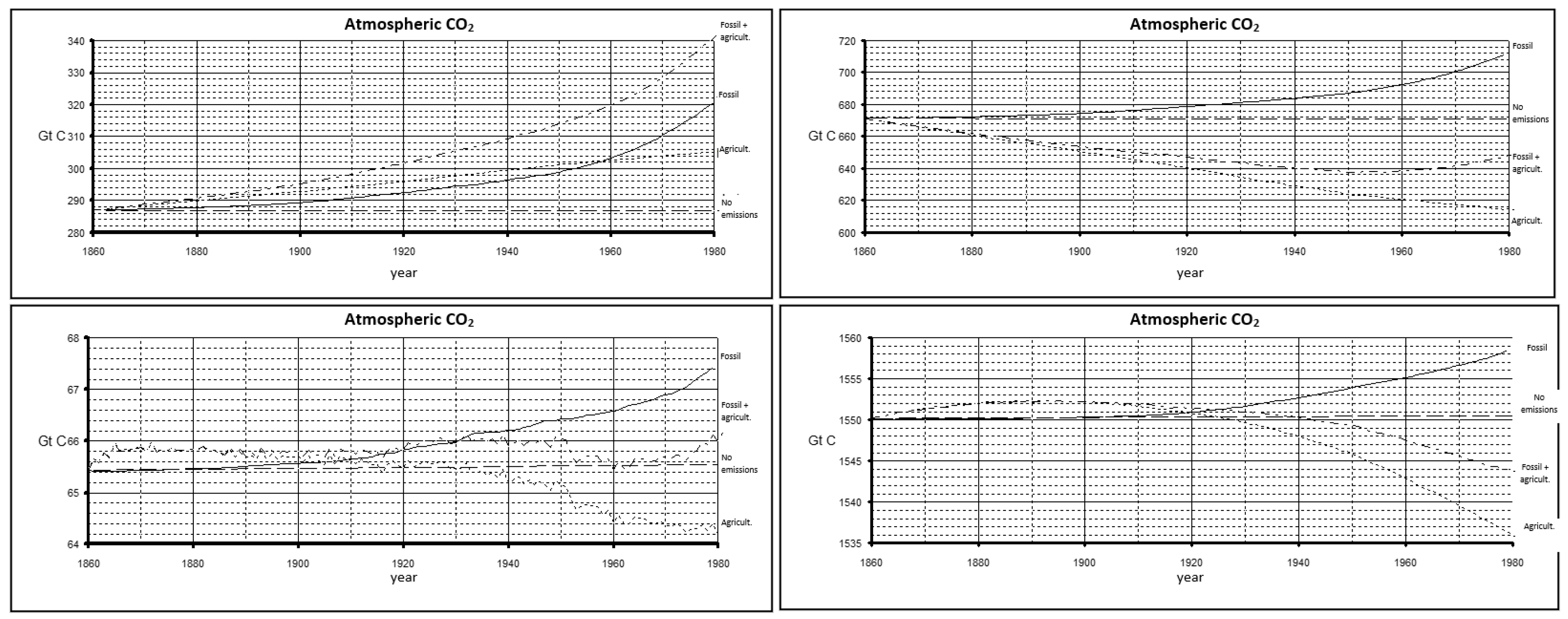
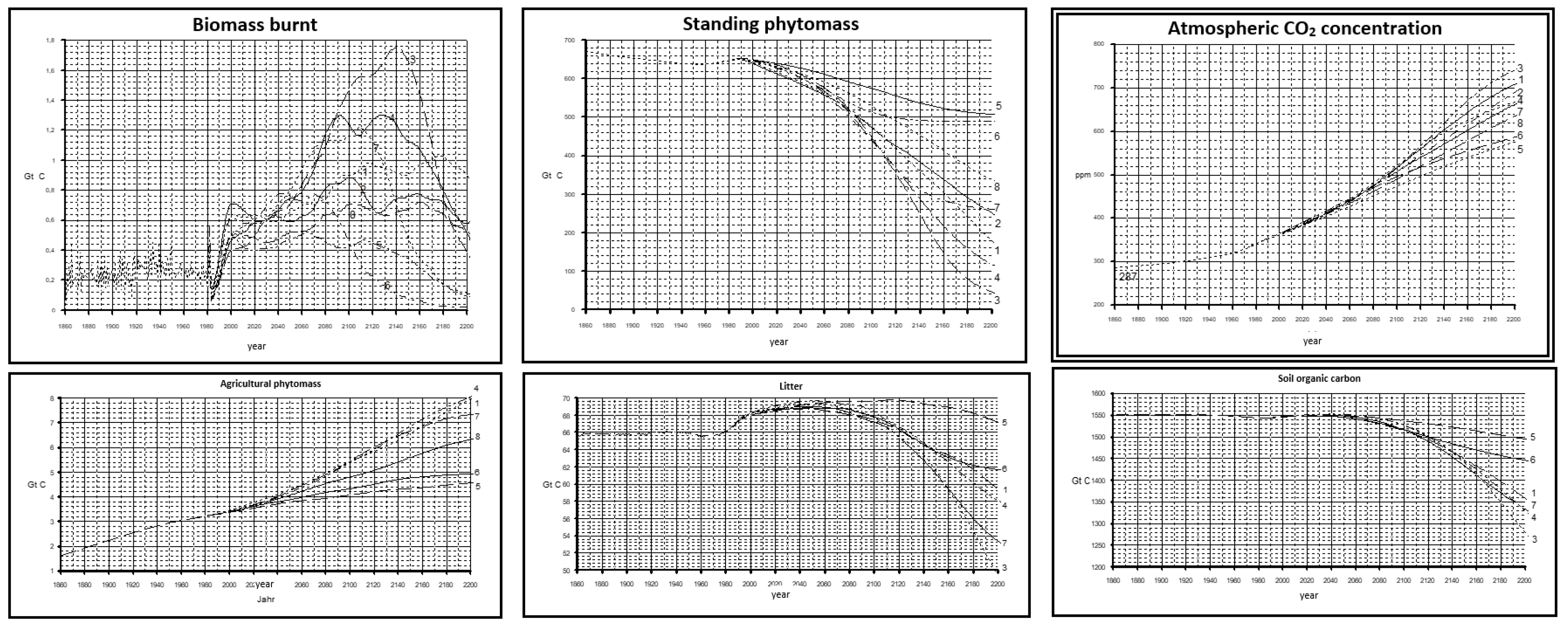
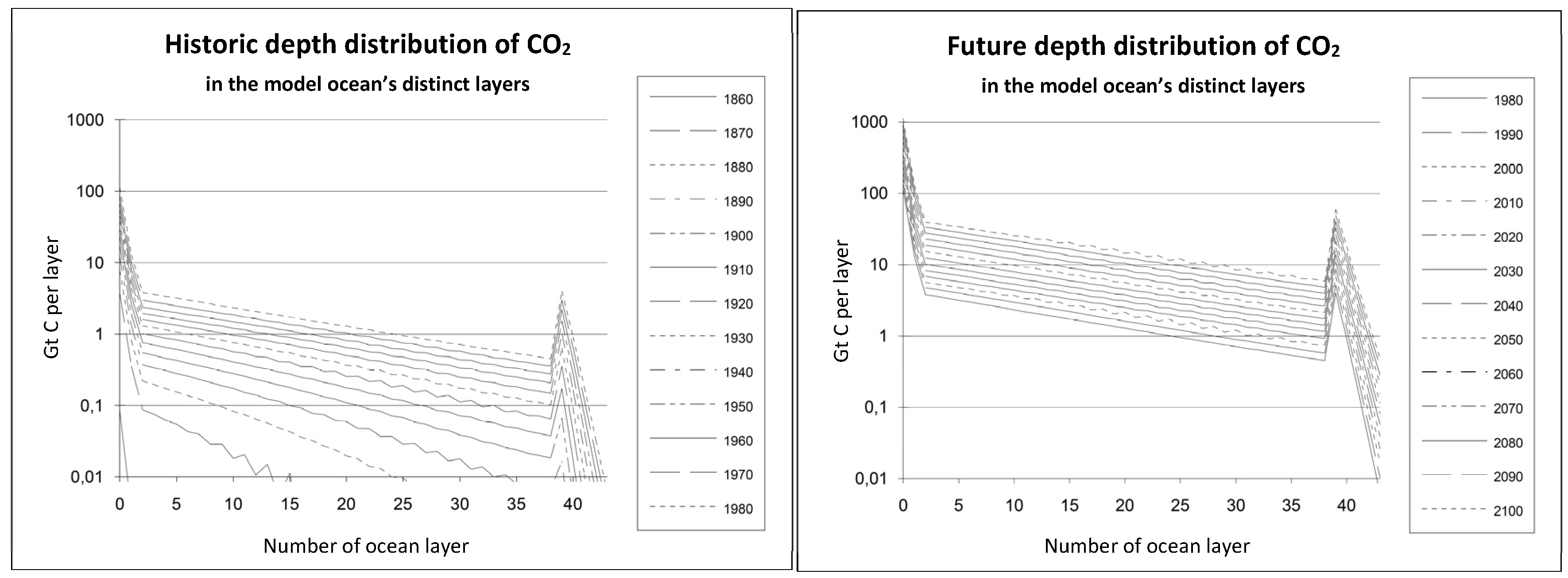
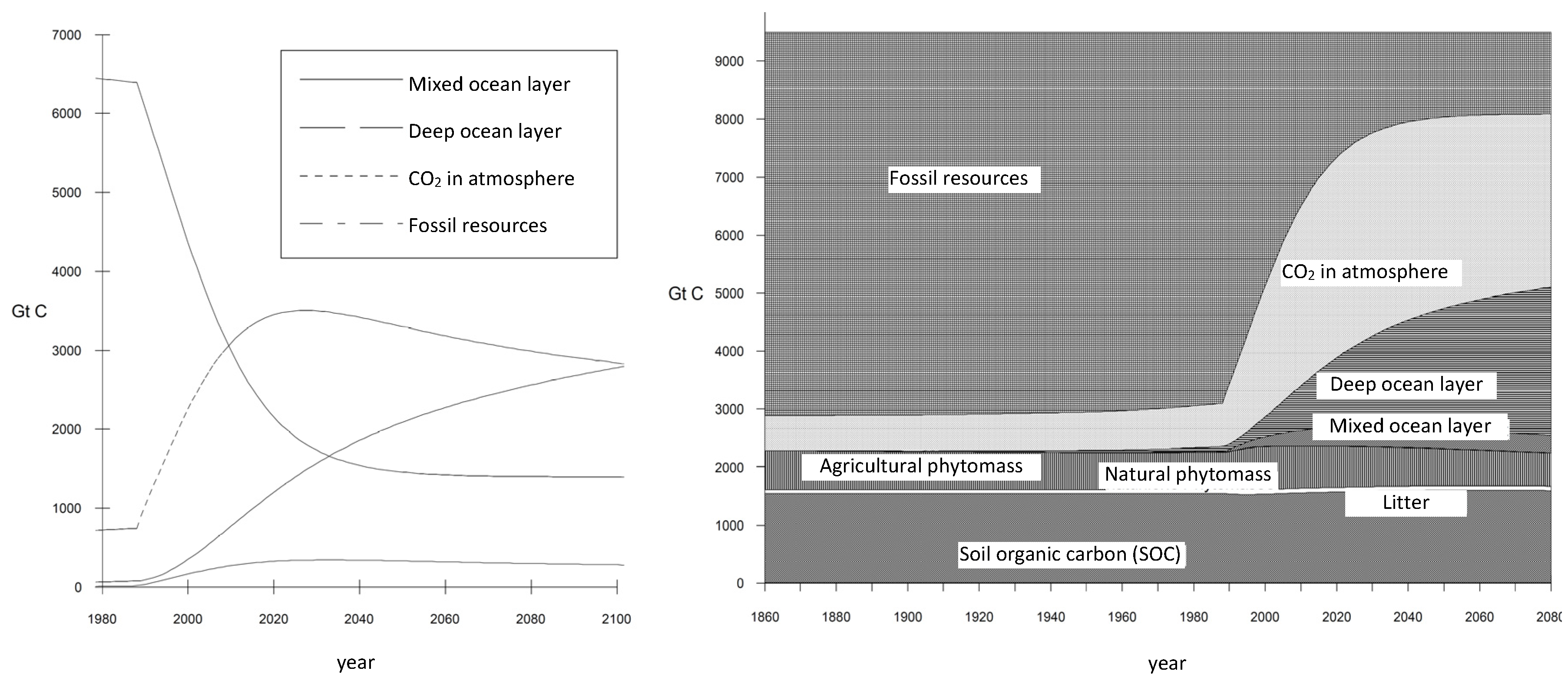

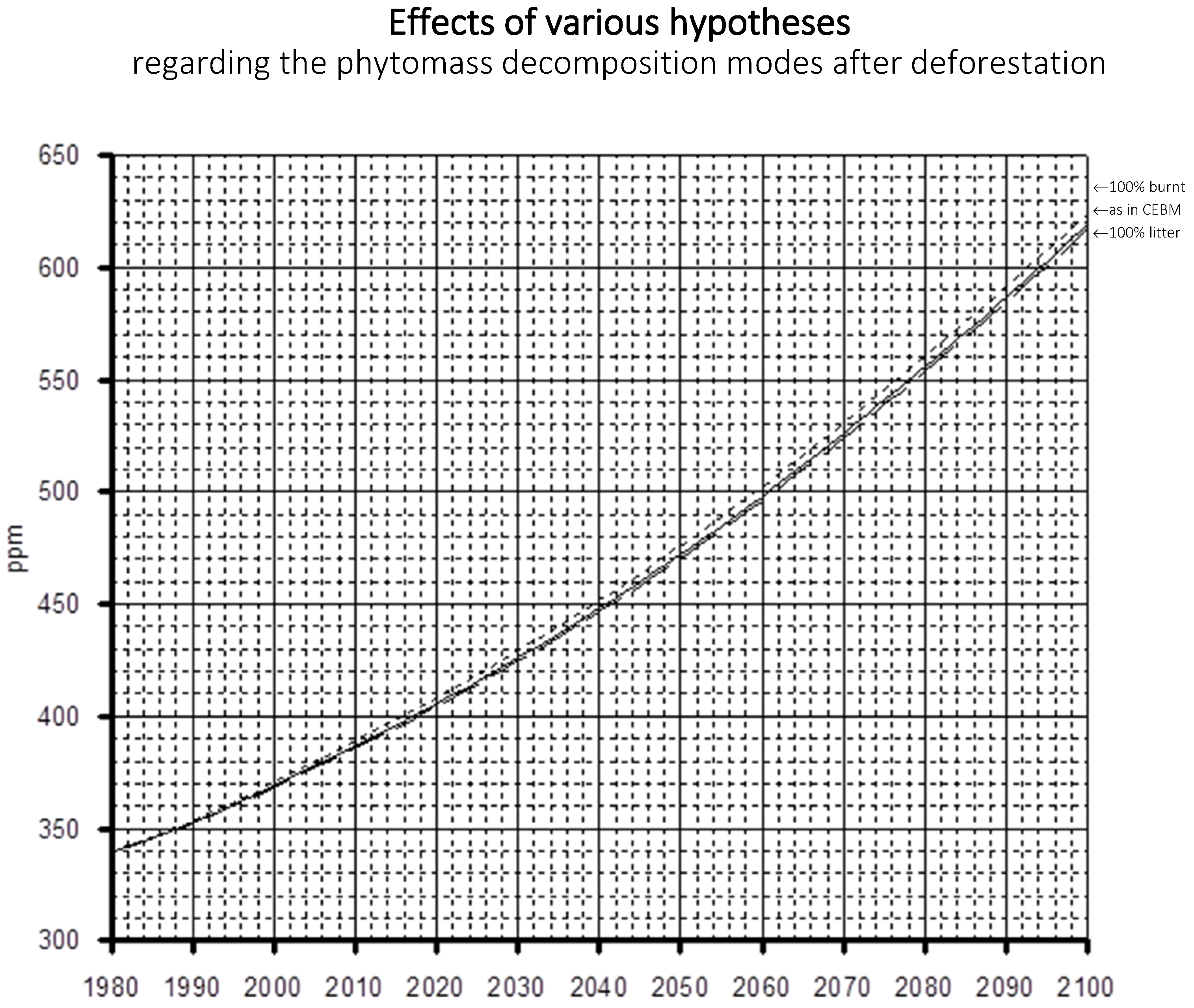
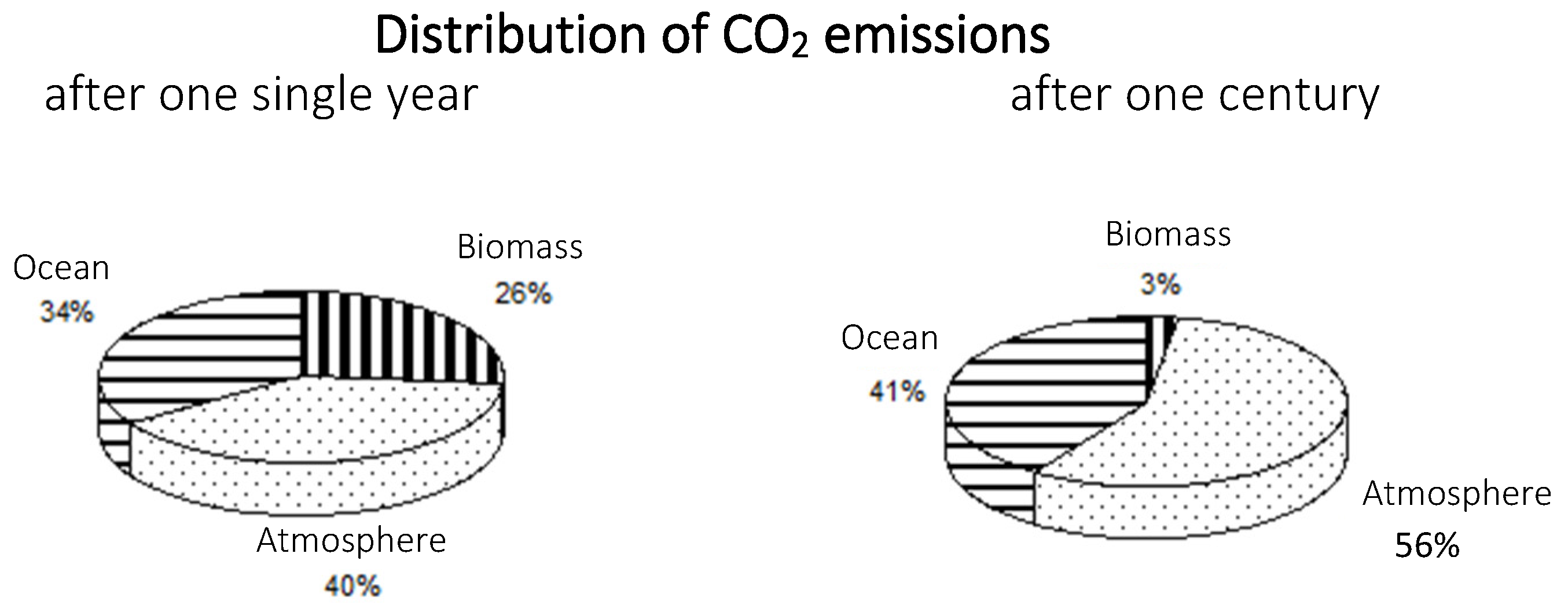
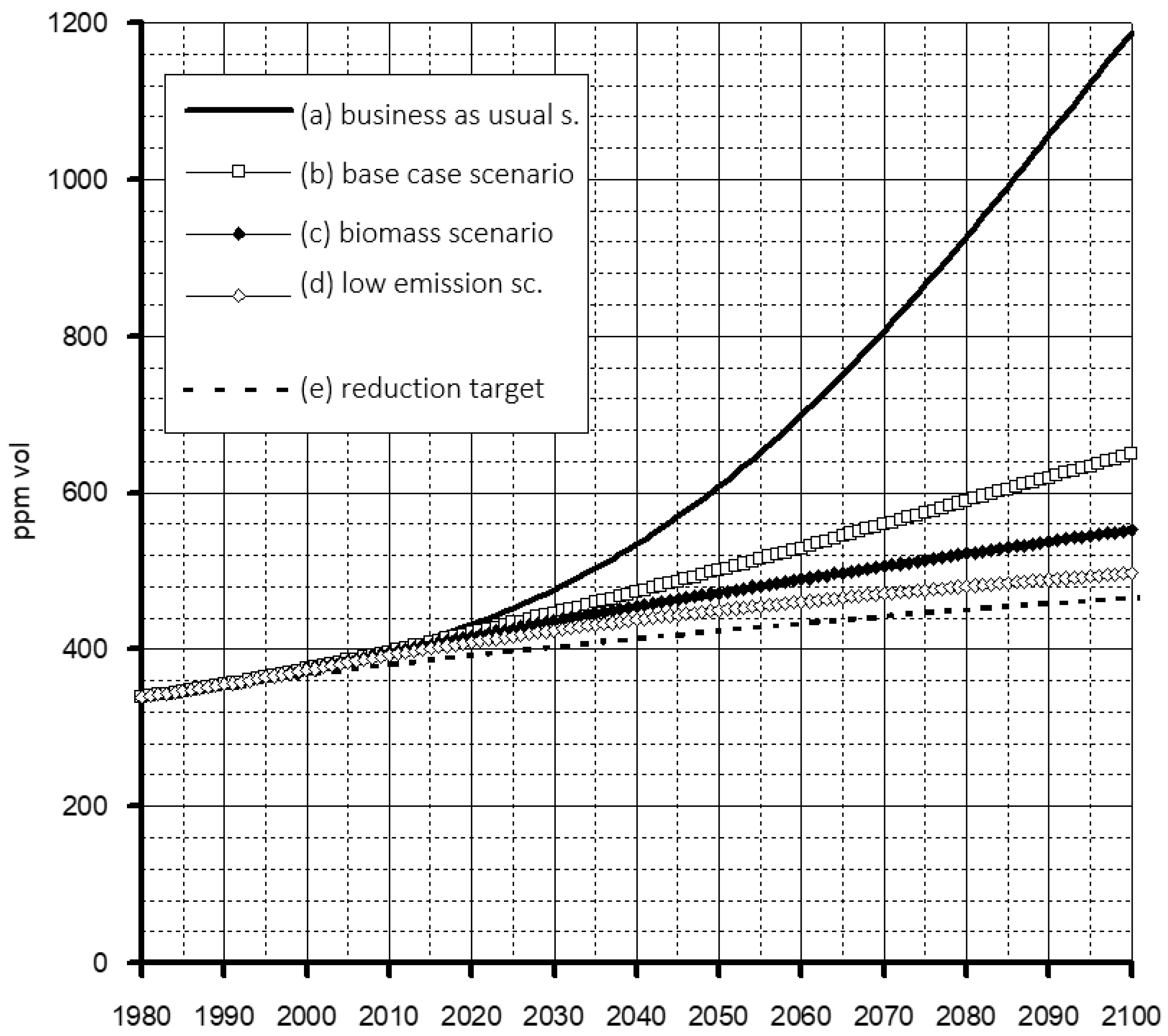
| Variable | Unit | Designation |
|---|---|---|
| CO2 | ppm vol | CO2 concentration in the atmosphere |
| FCO | Gt C | Fossil emissions accumulated over the years |
| PHYTE | Gt C | Global phytomass |
| NPP | Gt/a C | Global net primary productivity |
| LP | Gt/a C | Global inventory waste production (litter production) |
| LD | Gt/a C | Globally decomposed inventory waste (litter depletion) |
| M | Gt C | Accumulated increase in the oceanic mixed layer since 1860 |
| D | Gt C | Accumulated increase in the oceanic depth layer since 1860 |
| MD | Gt C | Accumulated increase in the total ocean since 1860 |
| Pnat | Gt C | Global natural phytomass |
| Pagr | Gt C | Global agricultural phytomass |
| NPPnat | Gt/a C | Global production of natural phytomass |
| NPPagr | Gt/a C | Global production of agricultural phytomass |
| DPHYT | Gt/a C | Globally cleared phytomass |
| SOC | Gt C | Global reservoir of soil organic carbon at the beginning of the year |
| SOCD | Gt/a C | Globally depleted soil carbon |
| BURNT | Gt/a C | Global total of cleared biomass |
| Balance | Gt/a C | Global balance of the atmosphere ⟶ biosphere flow |
| FCO | Gt/a C | Annual fossil CO2 emissions |
| CO2Gt | Gt C | CO2 in the atmosphere in Gt |
| Scenario | Atmospheric CO2 Content in the Year 2100 | CO2 Reduction Compared to the Trend Case for 2100 |
|---|---|---|
| Trend = business as usual (+3%/a increase in emissions due to the increase in energy demand) | approx. 1200 | - |
| global maximum biomass use (in trend scenario: +3%/a) | approx. 1000 | approx. −150 |
| Reducing the increase in emissions or energy demand from +3% to +1% (base scenario) | approx. 650 | approx. −550 |
| Combination of both methods (biomass scenario) | approx. 550 | approx. −650 |
| Reduction target (−1%/a) | approx. 450 | approx. −750 |
Disclaimer/Publisher’s Note: The statements, opinions and data contained in all publications are solely those of the individual author(s) and contributor(s) and not of MDPI and/or the editor(s). MDPI and/or the editor(s) disclaim responsibility for any injury to people or property resulting from any ideas, methods, instructions or products referred to in the content. |
© 2024 by the author. Licensee MDPI, Basel, Switzerland. This article is an open access article distributed under the terms and conditions of the Creative Commons Attribution (CC BY) license (https://creativecommons.org/licenses/by/4.0/).
Share and Cite
Ahamer, G. How to Compute Whether Biomass Fuels Are Carbon Neutral. C 2024, 10, 48. https://doi.org/10.3390/c10020048
Ahamer G. How to Compute Whether Biomass Fuels Are Carbon Neutral. C. 2024; 10(2):48. https://doi.org/10.3390/c10020048
Chicago/Turabian StyleAhamer, Gilbert. 2024. "How to Compute Whether Biomass Fuels Are Carbon Neutral" C 10, no. 2: 48. https://doi.org/10.3390/c10020048
APA StyleAhamer, G. (2024). How to Compute Whether Biomass Fuels Are Carbon Neutral. C, 10(2), 48. https://doi.org/10.3390/c10020048







